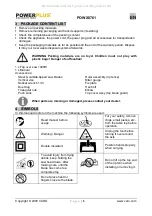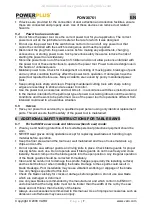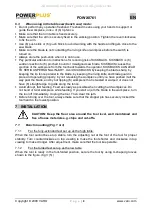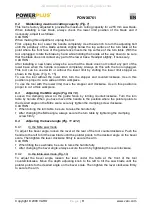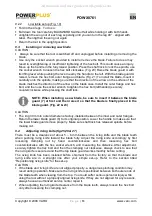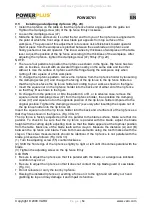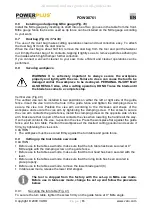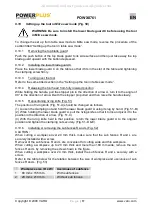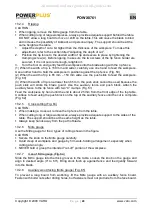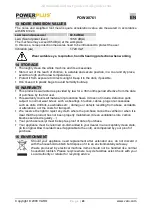
POWX0761
EN
Copyright © 2008 VARO
P a g e
|
19
www.varo.com
10.1.4
Compound cutting
Compound cutting is the process in which a bevel angle is made at the same time in which a
Mitre angle is being cut on a workpiece. Compound cutting can be performed at angle shown
in the table.
Bevel angle
Miter angle
45°
Left and Right 0
– 45°
When performing compound cutting, refer to “Press cutting”, “Mitre cutting” and “Bevel cut”
explanations.
10.1.5
Cutting aluminum extrusion (Fig. 56)
When securing aluminum extrusions, use spacer blocks or pieces of scrap as shown in the
figure to prevent deformation of the aluminum. Use a cutting lubricant when cutting the
aluminum extrusion to prevent buildup of the aluminum material on the blade.
CAUTION:
Never attempt to cut thick or round aluminum extrusions. Thick aluminum extrusions may
come loose during operation and round aluminum extrusions cannot be secured firmly with
this tool.
Never cut aluminum in the table saw mode (bench mode).
10.2
Cutting as table saw (bench mode)
CAUTION:
Always use “work helpers” such as push sticks and push blocks when there is a danger that
your hands or fingers will come close to the blade.
Always hold the workpiece firmly with the table and the rip fence. Do not bend or twist it
while feeding. If the workpiece is bent or twisted, dangerous kickbacks may occur.
NEVER withdraw the workpiece while the blade is running. If you must withdraw the
workpiece before completing a cut, first switch the tool off while holding the workpiece
firmly. Wait until the blade has come to a complete stop before withdrawing the workpiece.
Failure to do so may cause dangerous kickbacks.
NEVER remove cut-off material while the blade is running.
NEVER place your hands or fingers in the path of the saw blade.
Always secure the rip fence firmly, or dangerous kickbacks may occur.
Always use “work helpers” such as push sticks and push blocks when cutting small or
narrow workpieces, or when the ado head is hidden from view while cutting.
10.2.1
Work helpers
Push sticks, push blocks or auxiliary fence are types of “work helpers”. Use them to make safe,
sure cuts without the need for the operator to contact the blade with any part of the body.
10.2.2
Push block (Fig. 57)
Use a 19 mm piece of plywood. Handle should be in center of plywood piece. Fasten with glue
and wood screws as shown. Small piece 9.5 mm x 8 mm x 50 mm of wood must always be
glued to plywood to keep the blade from dulling if the operator cuts into push block by mistake.
(Never use nails in push block.)
10.2.3
Auxiliary fence (Fig. 58)
Make auxiliary fence from 9.5 mm and 19 mm plywood pieces.
All manuals and user guides at all-guides.com

